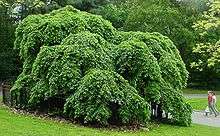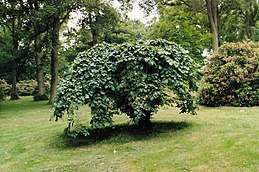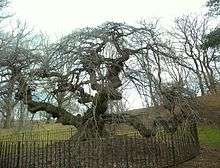Ulmus glabra 'Camperdownii'
The Wych Elm cultivar Ulmus glabra 'Camperdownii', commonly known as the Camperdown Elm, was discovered about 1835–1840 (often mis-stated as '1640') as a young contorted elm (a sport) growing in the forest at Camperdown House, in Dundee, Scotland, by the Earl of Camperdown's head forester, David Taylor. The young tree was lifted and replanted within the gardens of Camperdown House where it remains to this day. The original tree, which grows on its own roots, is less than 3 m tall, with a weeping habit and contorted branch structure. The earl's gardener is said to have produced the first of what are commonly recognised as Camperdown elms by grafting a cutting to the trunk of a wych elm (U. glabra).
| Ulmus glabra 'Camperdownii' | |
|---|---|
 Camperdown Elm, Prospect Park (Brooklyn) | |
| Species | Ulmus glabra |
| Cultivar | 'Camperdownii' |
| Origin | Scotland |

Henry and Bean record that in early days both 'Camperdownii' and a reportedly similar-looking cultivar called 'Serpentina' were marketed as U. montana pendula nova.[1][2][2] Koch had listed an U. serpentina in 1872,[3] and an U. montana serpentina was marketed in the late 19th century and early 20th by the Späth nursery in Berlin,[4] and by the Ulrich nursery in Warsaw.[5] In Späth catalogues between 1902 and 1920, 'Serpentina' appears while 'Camperdownii' is absent; by 1930 'Camperdownii' appears but 'Serpentina' is absent. This suggests that 'Serpentina' may have been a continental name for 'Camperdownii', and that Späth dropped the name 'Serpentina' c.1930 in favour of 'Camperdownii'. Elwes and Henry's failure to mention the serpentining branches of 'Camperdownii' may have contributed to the impression of two different trees. In this omission they were followed by Bean (1925; corrected 1981),[2] Green (1964), Hillier (1972– 2002),[6] Krüssmann (1976),[7] and White (2003),[8] the first four of whom, like Elwes and Henry, list 'Serpentina' as a cultivar distinct from 'Camperdownii'.
Although usually classed as a cultivar of wych elm,[9] the tree was considered a nothomorph of Ulmus × hollandica 'Vegeta' by Green (1964).[10]
The tree is sometimes confused with the 'Horizontalis' (Weeping Wych Elm) owing to both being given the epithet 'Pendula'.[10]
Description
The grafted Camperdown Elm slowly develops a broad, flat head that may eventually build as high as 4 m (13 feet), and a commensurately wide crown with a weeping habit.[8] Its chief diagnostic feature is its contorted branching, what Mitchell (1982) called the "head of furiously twisting branches".[11]
The ultimate size and form of 'Camperdownii' depends on such factors as latitude and location, on what part of the parent tree the cuttings come from, on the 'stock' on which it is grafted, and on possible continuing mutation. Specimens may therefore vary in appearance.[12] Grown in lower latitudes like Victoria, Australia, the tree can attain a height and spread of over 13 m.[13][14]
- Distinctive narrow Camperdown samarae, showing the seed on the stalk side of centre (typical of wych)
 Dried short-shoot 'Camperdownii' leaves (August)
Dried short-shoot 'Camperdownii' leaves (August) Camperdown Elm grafted on Siberian elm stock, Serbia
Camperdown Elm grafted on Siberian elm stock, Serbia Extreme contortion in the trunk and branches of Camperdown Elm, Port Gamble, Washington
Extreme contortion in the trunk and branches of Camperdown Elm, Port Gamble, Washington
Pests and diseases
'Camperdownii' is susceptible to Dutch elm disease, however, there are still many examples to be found in parks and gardens across the British Isles as it often avoids detection by the Scolytae beetle (a major vector of Dutch elm disease) because of its diminutive height. In North America it often escapes infection possibly because the American vectors of the disease do not feed on wych elm, however, its leaves are heavily damaged there by the elm leaf beetle Xanthogaleruca luteola,[15] elm yellows , and disfigured by leaf-mining and leaf-rolling insects, such as the elm casebearer, Coleophora ulmifoliella .
- A Camperdown Elm at Spier's parklands that is infected with Rigidoporous ulmarius
 Slime flux on Camperdown Elm
Slime flux on Camperdown Elm
Cultivation
Every 'Camperdownii' is descended (through cuttings) from the original sport and usually grafted on a wych elm trunk.[16] Other grafting stock has been used, including Dutch elm U. × hollandica, Siberian elm U. pumila, and English elm U. minor 'Atinia' (although this ultimately produces suckers).
Camperdown elms satisfied a mid-Victorian passion for curiosities in the 'Gardenesque' gardens then in vogue. Many examples were planted, as 'rarities', in Britain and America. There are many on university campuses, often planted as memorials, such as at the campus of the University of Idaho. Others featured in townscapes such as at the Lakeview Cemetery, Seattle, and Kripalu Yoga Center, Stockbridge, MA.
The tree was also introduced to Australia, where a number still survive, notably in Victoria, where it was marketed from 1873.[17][18]
Camperdown Elm is cold hardy, suffering more from summer drought than winter cold (to zone 4), although 90% of the University of Minnesota elm trials specimens were lost during the exceptionally severe winter of 2002–2003.[19]
_(21090678910).jpg) Camperdown Elm, 1891 (from Ellwanger and Barry's catalogue, New York)[20]
Camperdown Elm, 1891 (from Ellwanger and Barry's catalogue, New York)[20] Young Camperdown elms grafted on Siberian elm stock, Saints Cyril and Methodius Park, Belgrade
Young Camperdown elms grafted on Siberian elm stock, Saints Cyril and Methodius Park, Belgrade Camperdown in autumn, Royal Botanical Garden, Madrid
Camperdown in autumn, Royal Botanical Garden, Madrid
Notable trees
In Dundee, Scotland, there are two well established Camperdownii Elms at the gated entrance to a private residence on Constitution Terrace in the Crescents Conservation Area. Both trees have grown so they intertwine with each other and create the illusion of one tree in the summer months. The trees are likely to have been cultivated around 1850, the same age as the Victorian mansion situated in the grounds which was built around 1850, therefore are among the oldest in Dundee. These trees are the only known 'twin trees' of their kind.[21] [22]
In Prospect Park, Brooklyn, a Camperdown Elm planted in 1872 near the Boat House has developed into a picturesque weatherbeaten specimen, no more than four metres high, like an oversized bonsai. Described by the poet Marianne Moore as "our crowning curio," the Prospect Park tree is considered the outstanding specimen tree in the park.[23] Halifax Public Gardens contains a similar specimen, located next to the Boer War Memorial fountain, which displays the same characteristics as the Prospect Park tree.
The UK TROBI Champion trees are in Scotland, at Baxter Gardens, Dundee, and at Ayr Cemetery.[24] In France, two grow by the gate at corner of rue de Buzenval and rue de Lagney in the Square Sarah Bernhardt, Paris (20th Arrondissement). NB: Two Corkscrew Willows at the entrance near the corner of rue de Lagny & rue Mounet Sully look the same during winter.
In Gardner, Massachusetts, there is a Camperdown Elm on Parker Street in the front yard of a former store now currently a private residence, towering over the peak of the two-story building with a trunk circumference of over 9 feet. The tree has not been touched for decades and is infested with leaf miners and borers; there is also a significant amount of trunk rot and large missing limbs. As of late June 2010, a local resident, Nate Thibault, has taken action to create a restoration plan for the tree. The tree's age is undetermined but believed to have reached its maturity.
There is a Camperdown Elm on the Smith College Campus which was planted as an aboretum by F. Ulmstead at the turn of the 20th Century.
In Warrenton, Oregon there is a Camperdown Elm on the property of the DK Warren House. This is actually 2 trees that have intertwined together for a spectacular canopy. www.dkwarrenhouse.com, Circa. 1885
In Port Gamble, Washington there is a Camperdown Elm next to the historic Walker-Ames House. Planted in 1875, this individual measures 20 feet tall, with a 26-foot crown and 7-foot trunk circumference.
In Alfred, NY the “Umbrella Tree” is a beloved landmark on the Alfred University campus. Frequently it's a temporary home to students nestled in its branches or artwork hanging from its limbs. Found in front of the Powell Campus Center it was planted circa 1905. Originally it sat in front of Kenyon Memorial Hall, the first building on this site. It once had a “twin” located just a few yards away that was removed in 1974 due to ill health. A third one was once located next to the School of Theology building (The Gothic), currently the site of Herrick Memorial Library.[25]
In Saint John, New Brunswick, there is a Camperdown Elm on Red Head Road on the front yard of a former farm, currently a private residence. The owner is currently trying to locate the tree's history; its age is undetermined.
In Leamington, Ontario, there is a mature Camperdown Elm on Seacliff Drive in the back yard of a garden center.
In Eastport, Maine, there is a Camperdown Elm at the corner of High Street and Shackford Street. The tree is on the corner near the original Anderson home built circa the 1850s. It is 3 feet in diameter at the widest part of its trunk. Eastport is the easternmost city in the United States.
In Spiers Old School Grounds near Beith, Scotland is a fine specimen dating from the late 1880s planted by the Earl of Eglinton's head gardener on behalf of the Spier's Trust (see photograph).
In Newport, Rhode Island, there is a Camperdown Elm at the Chinese Tea House in the Marble House estate, a historic mansion built by Mr. and Mrs. William Kissam Vanderbilt between 1888 and 1892, which is open to the public.
In Cazenovia, New York, there is a Camperdown Elm planted in the gardens of The Brewster Inn.
Among the largest known Camperdown Elms are the pair outside 315 Eureka Street, Ballarat, Victoria, Australia, (2014), planted c.1900. Measured in 2011, one (girth 2.7 m) was 13.7 m tall and 14.3 m broad, the other (girth 2.6 m) 13 m tall and 13 m broad.[13]
 Weeping Elm, Halifax Public Gardens
Weeping Elm, Halifax Public Gardens- Unmaintained Camperdown Elm, Gardner MA 01440
 A Camperdown Elm located in Port Gamble, Washington. Planted 1875
A Camperdown Elm located in Port Gamble, Washington. Planted 1875- Parc du Bois-de-Coulonge, Quebec City
 Red Head Road, Saint John, NB
Red Head Road, Saint John, NB Prospect Park's elm in winter, showing its distinctive qualities
Prospect Park's elm in winter, showing its distinctive qualities Camperdown Elm, Seacliff Drive, Leamington, Ontario, Canada
Camperdown Elm, Seacliff Drive, Leamington, Ontario, Canada
Synonymy
- Ulmus glabra 'Camperdownii'
- Ulmus montana (: glabra) var. pendula: Kirchner, in Petzold & Kirchner, Arboretum Muscaviense, 565, 1864.
- Ulmus montana (: glabra) var. pendula camperdownii Hort.: Henry, in Henry & Elwes, Trees of Great Britain & Ireland, 7: 1867, 1913.
- Ulmus montana (: glabra) pendula nova Hort.: Kirchner, in Petzold & Kirchner, Arboretum Muscaviense 565, 1864, name in synonymy.
- Ulmus scampstoniensis pendula: Petzold, in Petzold & Kirchner, Arboretum Muscaviense 565, 1864.
Accessions
North America
- Arnold Arboretum, US. Acc. no. 352–51.
- Bartlett Tree Experts , US. Acc. nos. 1375, 2002–221.
- Brooklyn Botanic Garden , New York, US. Acc. no. 240001.
- Chicago Botanic Garden, Glencoe, Illinois, US. One tree, in the Parking Lots, listed as U. × vegeta 'Camperdownii'.
- Dominion Arboretum, Ottawa, Ontario, Canada. No acc. details available.
- Detroit Institute of Art, Detroit, Michigan, US. 2 Specimens frame the entranceway.
- Eisenhower Park, Newport, Rhode Island, US.
- Filoli Estate & Gardens, Woodside, California, US. No acc. details available.
- Gilman Park Arboretum , Pierce, Nebraska, US. No acc. details available.
- Grounds for Sculpture, Hamilton, New Jersey, US. One specimen in the Water Garden to the left of the sculpture "Relative"
- Hoyt Arboretum, Portland, Oregon, US. No acc. details available.
- Longwood Gardens, US. Acc. no. 2000–1338.
- New York Botanical Garden, US. Acc. no. 529/89.
- Scott Arboretum, US. Acc. no. 70–163
- Smith College, US. Acc. no. 3166PA.
- University of Idaho, Moscow, Idaho, US.
- Washington Park Arboretum, Seattle, US. No acc. details available.
Europe
- Arboretum de La Petite Loiterie , Monthodon, France. No details available
- Brighton & Hove, UK. National Elm Collection- Scattered throughout the city. Recent additions have occurred at Withdean and Preston Parks.
- Cambridge Botanic Garden , University of Cambridge, UK. No accession details available.
- Grange Farm Arboretum, Lincolnshire, UK. Acc. no. 512.
- Hortus Botanicus Nationalis, Salaspils, Latvia. Acc. no. 18099.
- Linnaean Gardens of Uppsala, Sweden. Acc. no. 1976–1049.
- Newby Hall and Gardens: near Ripon, North Yorkshire, UK. Two examples. No planting dates available.
- Tallinn Botanic Garden, Estonia. . No accession details available.
- Westonbirt Arboretum , Tetbury, Glos., UK. No planting date or acc. no. available.
- Wijdemeren City Council, Netherlands. Elm collection. 2 exx. 4 m high at cemeteries Rading, Loosdrecht and Hornhof, Nederhorst den Berg. Planted in 2015.
Australasia
- Eastwoodhill Arboretum , Gisborne, New Zealand. 3 trees, details not known.
- Morton House, Charles Street, Launceston, Australia. 1 tree.
- Orange Botanic Gardens, Orange, New South Wales, Australia, 1 tree.
Nurseries
North America
(Widely available)
Europe
(Widely available)
References
- Elwes, Henry John; Henry, Augustine (1913). The Trees of Great Britain & Ireland. 7. p. 1884.
- Bean, W. J. (1981). Trees and shrubs hardy in Great Britain, 7th edition. Murray, England, p.646
- Koch, Karl (1872). Dendrologie; Bäume, Sträucher und Halbsträucher, welche in Mittel- und Nord- Europa im Freien kultivirt werden. 2. p. 417.
- Katalog (PDF). 108. Berlin, Germany: L. Späth Baumschulenweg. 1902–1903. pp. 132–133.
- Ulrich, C. (1894), Katalog Drzew i Krezewow, C. Ulrich, Rok 1893-94, Warszawa
- The Hillier manual of trees & shrubs. Newton Abbot: David & Charles. 2002. ISBN 978-0-7153-1073-1.
- Krüssman, Gerd, Manual of Cultivated Broad-Leaved Trees & Shrubs (1976, trans 1984 vol. 3)
- More, David; White, John (2003). Cassell's trees of Britain & Northern Europe. London: Cassell. ISBN 978-0-304-36192-2.
- Coleman, Max (2009). Wych Elm. Royal Botanic Gardens Edinburgh. ISBN 978-1-906129-21-7.
- Green, Peter Shaw (1964). "Registration of cultivar names in Ulmus". Arnoldia. Arnold Arboretum, Harvard University. 24 (6–8): 41–80. Retrieved 16 February 2017.
- Mitchell, Alan (1982). The trees of Britain and Northern Europe. London: Collins. ISBN 978-0-00-219037-4.
- Information from RBGE.
- 315 Eureka Street 'Camperdownii', Ballarat, Victoria ; trees may also be seen on Google Streetview
- Phillips, Roger (1978). Trees in Britain, Europe and North America. London: Pan Books. ISBN 978-0-330-25480-9.
- "Elm Leaf Beetle Survey". Archived from the original on 2011-07-19. Retrieved 17 July 2017.
- "Pine Tree Cemetery's Camperdown Elms". corunna-mi.gov. Retrieved 2017-08-24.
- Brookes, Margaret, & Barley, Richard, Plants listed in nursery catalogues in Victoria, 1855-1889 (Ornamental Plant Collection Association, South Yarra, Victoria, 1992), p.303–304
- 'Camperdownii in Victoria
- Giblin, C. P. & Gillman, J. H. (2006). Elms for the Twin Cities: A Guide for Selection and Maintenance. University of Minnesota.
- Ellwanger and Barry cat. 1899, p.62, has a second photo
- Dundee City Council. "Dundee's Tree & Woodland Heritage" (PDF). dundeecity.gov.uk. Retrieved 2017-08-24.
- Dundee City Council. "Crescents Conservation Area Appraisal" (PDF). dundeecity.gov.uk. Retrieved 2017-08-24.
- Moore, Marianne (1994). "The Camperdown Elm". Complete poems. New York: Macmillan Penguin Books. ISBN 978-0-14-018851-6.
- Johnson, O. (2011). Champion Trees of Britain & Ireland, p. 168. Kew Publishing, Kew, London. ISBN 9781842464526.
- "The Umbrella Tree". Alfred University Archives Blog. Retrieved 2017-08-24.